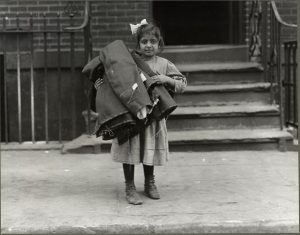
WEEK 1: The Sweatshop Read these short articles by the Smithsonian Institution’s National Museum of American History:
- History of sweatshops
- Sweatshops 1820-1880
- Sweatshops 1880-1940
- Sweatshops 1940-1997
- Read more about the Triangle Shirtwaist Factory Fire (March 25, 1911)
- Review this timeline of labor reform laws including the Fair Labor Standards Act of 1938. This legislation set up our contemporary notions of employer responsibility, often referred to after WW II as “Fair Trade.”
Fair Trade Discussion Board See Blackboard for assignment details and prompt for the Discussion Board responding to fair trade practices, based on current events in Fashion

WEEK 2: Labor Laws and Corporate Responsibility
What is Fair Trade? Read about the definition of “Fair Trade” and how the shortcomings in modern-day industry has led corporations to become more socially responsible.
TEXTBOOK: Jiminez, Guillermo C. and Elizabeth Pulos. Good Corporation, Bad Corporation: Corporate Social Responsibility in the Global Economy. ![]() Open SUNY: 2016. ISBN 13: 9781942341253
Open SUNY: 2016. ISBN 13: 9781942341253
- Ch. 8: “Fair Trade” Read the first two sections of this chapter, “Fair Trade: Conscious Consumerism Comes to Coffee” and “The Origins of Fair Trade”
- CH. 9: “CSR and Sweatshops” Read this chapter in its entirety to gain an understanding of corporate social responsibility (CSR) and how fashion industry practices contribute to global concerns about sweatshops
WEEK 3: See Blackboard for the assignment details on the comparison of sweatshops, then and now
Print this page


